Our climate adaptation mission gets a boost when we do our first “field survey” of communities in Cambodia which have already successfully adapted to rising water levels.
The two days we spend visiting with the families on the water are not only informative, but akin to being on a different planet. The feeling is exhilirating. The sheer expanse of so many families living their daily lives on the water – staring down climate change – is inspirational!
The overwhelming impression we have is that we are getting just a “glimpse of the future”. Given the reality that sea level rise will result in over one meter rise in water level by end of the century, we are fully expecting to see a transition to water borne living within our lifetime.
The thing is: it seems remote to most when we talk about the impact on the planet of sea level rise over the next hundred years. But it is not as though we get to “coast” for ninety nine years and then BAM New York, London and Sao Paolo are under water.
Rather, we should brace ourselves for a constant stream of flood related crises in all regions. Climate Change is here now and hundreds of millions of people are already affected, all over the world.
The community of Kompong Khleang is a role model for people living near water (rivers, lakes, the ocean).
Tonle Sap Lake is Cambodia’s great lake, that sustains the country with its fertile sediments and abundance of fish.
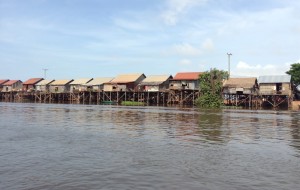 |
| 1800 people live in this community. These houses are on very tall stilts, which are only halfway covered right now by the water level. |
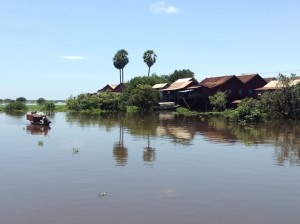 |
| Breathtakingly beautiful scenes of life on the water |
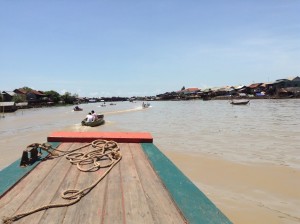 |
| From our boat, we can see the houses on stilts on both sides, as well as the constant boat activity on the river. |
|
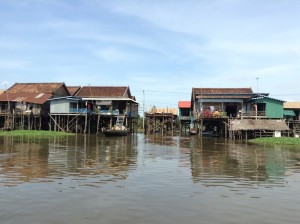
|
| Multiple rows of houses with neighborhood “blocks” and “streets”. |
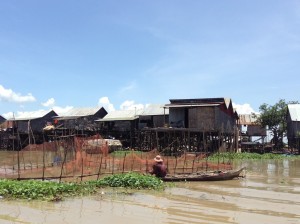 |
| A man tending to his shrimp farm in front of his home. |
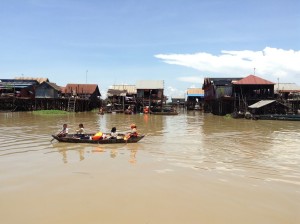 |
| Children head to school by boat bus. |
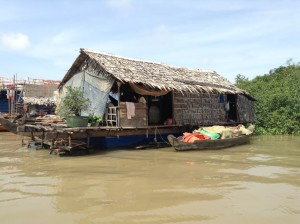 |
| After the houses on stilts, come the floating house neighborhood. |
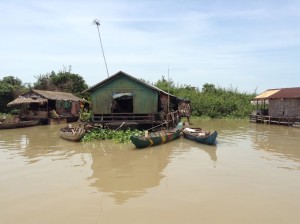 |
| Each house has its own boats for getting around. This house has a small wind turbine for energy. |
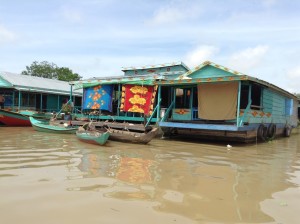 |
| Many of the house boats have painted designs around the roof and side banisters. Even though the houses are floating, they are sometimes clustered fairly close together creating a community neighborhood feel. |
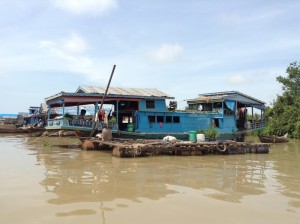 |
| Some homes are very large and spacious with second level balconies. The full economic spectrum in one community is a noteworthy aspect of this floating community where rich and poor, Cambodian and Vietnamese immigrants co-habitate on the water. |
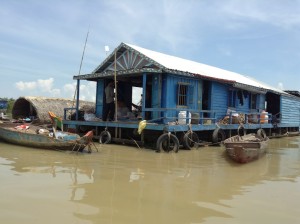 |
| How cute and pretty is this blue house? |
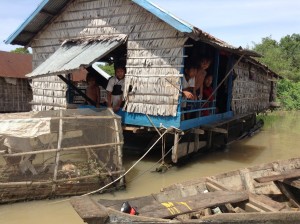 |
| The children in the household are all eager to see who is coming! Note the chickens and ducks on water on the left. |
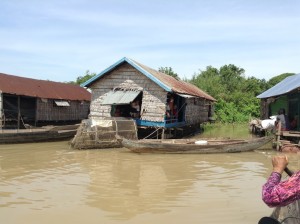 |
| We have arranged to rent a small row boat with a community member who rows us to meet local families. This one in the photo has a small chicken coop floating up front. |
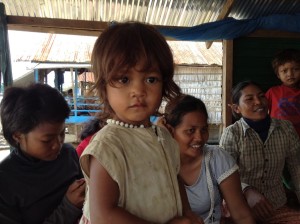 |
| I love this little girl! |
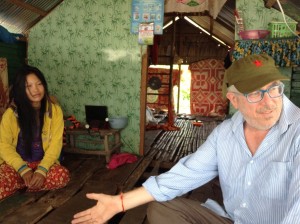 |
| We sit in front of the houseboat with the all female household. We hired a translator so that we can have discussions with the local families we meet. At the back is where the family cooks and sleeps. |
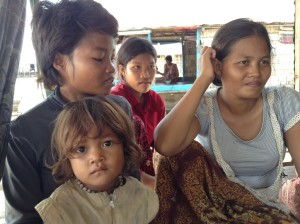 |
| Everybody in this family was born on the water, as were their parents and their grandparents. |
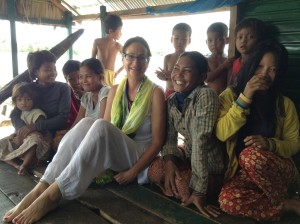 |
| Despite the language barrier, the feeling is very warm and of a shared moment together. |
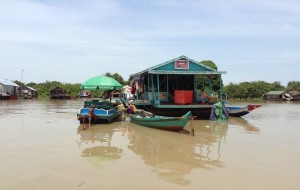 |
| This house with the umbrella patio, would not be out of place in any European or US water front communities. |
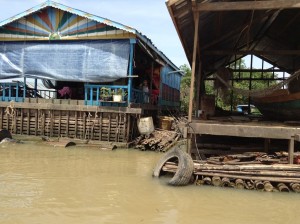 |
| Note the bamboo on the right under the house, used as part of the floating system. |
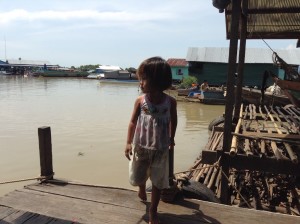 |
| “hello….” |
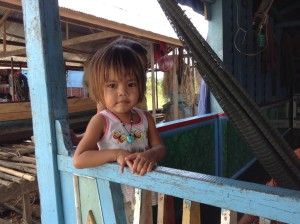 |
| Very happy with herself…. |
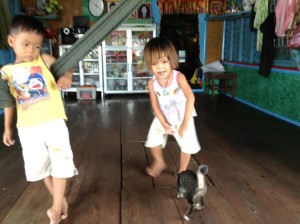 |
| Hamming it up… with a chopstick in her mouth and a kitten to play with |
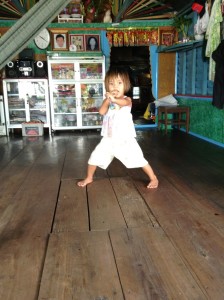 |
| Demonstrating Cambodian Kung fu. The wooden floors in all the houses we visit, are very smooth, soft and cool. |
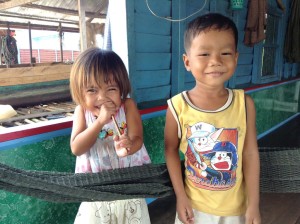 |
| The digital pictures of herself on my ipad, create shrieks of joy and laughter |
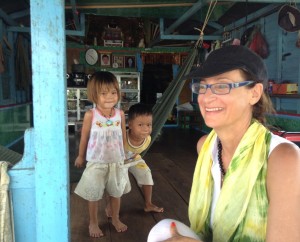
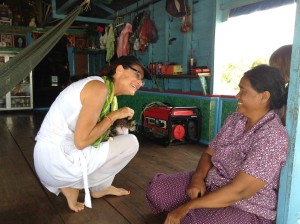 |
| Cross cultural communication with the help of kitten |
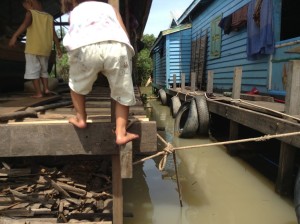 |
| And finally, as we are about to leave by boat, she leaves too and makes her way back to her house next door, using the rope to help keep her balance on a few boards between the houses. |
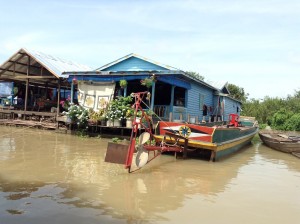 |
| Many of the homes have lovely patio areas out font, with their boats docked next to the house. |
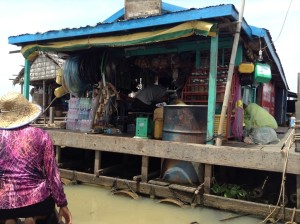 |
| Here we arrive at the neighborhood 7/11 or “Pulperia”… store with basic stuff. |
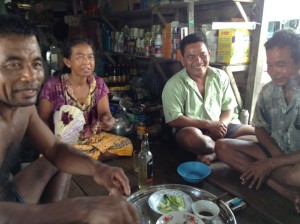 |
| The couple on the left own the houseboat which doubles as house and store. Friends come over for a drink and meal. |
|
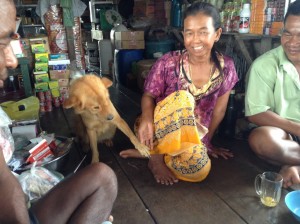
|
| Only afterwards I thought about the fact that we did not have language in common, but how little that mattered in these moments we shared together. |
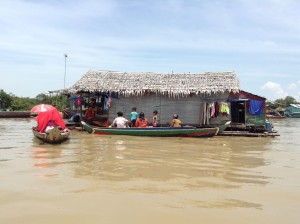 |
| Laundry hangs at the back of the house as friends pull up by boat to visit |
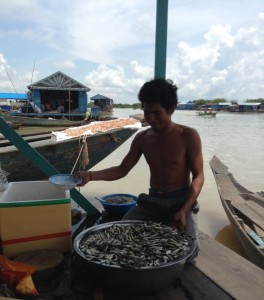 |
| This family makes a living by fishing. Aside from what they catch daily, there is also a trap door in the floor which lifts up to access the fish “farm” which is enclosed under the house in an enormous floating “cage”. |
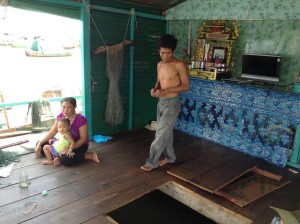 |
| The trap door to the family cat fish farm that is enclosed under the floor. |
 |
| Nice designs on the roofs. Modern speed boat in the front. |
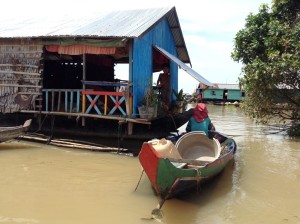 |
| Vendor pulls up her boat to sell to customers. |
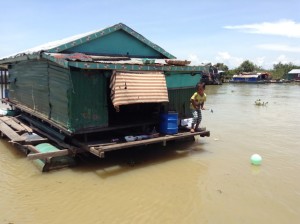 |
| This little boy dropped his ball into the water and is trying to retrieve it with a soup spatula. |
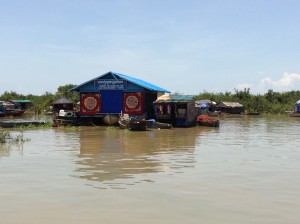 |
| Neighborhood floating school. |
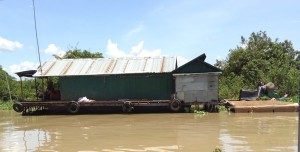 |
| Floating veg garden at back. |
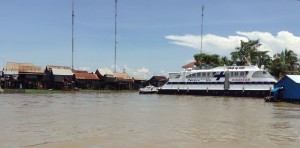 |
| French NGO “Ship of Life” which provides medical support to the amphibious community. |
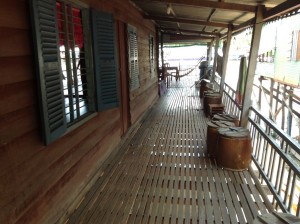 |
| Ceramic barrels on the right of this patio, are used as rain water catchment systems. |



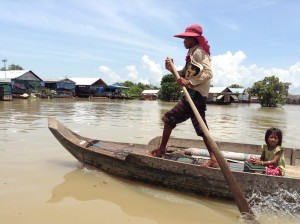


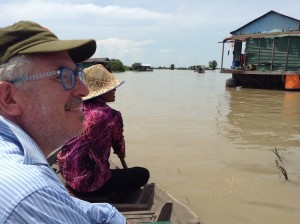










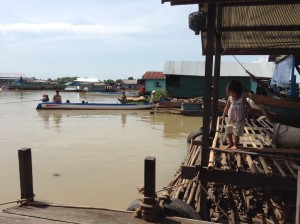
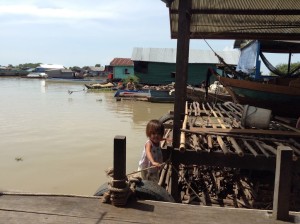
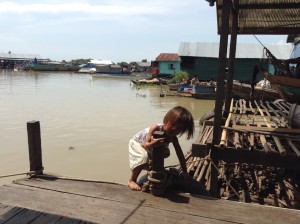
























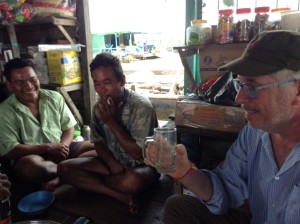


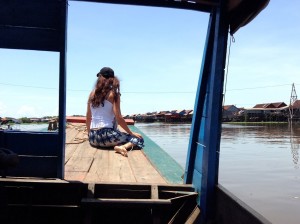
Very interesting. My first thought however is the children safety… Do they know how to swim? how old are they when they start climbing the rope? etc… with water all around…??
Sophie: We asked specifically about the risk to children and there are two “voices”. Asked if the kids could swim, the residents answered “of course”. The water is as natural to them, as land is to most of us. small babies sleep in hammocks and toddlers are watched by family members, until they ready to start exploring on their own, including walking the rope to the neighbor’s house, much like children on land. The little girl who paid us a visit was 4, and clearly this wasn’t her first rope walk…
It just keeps getting more exotic. I, of course, love the floating chicken coop and garden, and I’m relieved to know they deliver coffee. very civilized!
Are these small statured people? Peta looks rather giant in some of the pictures.
Great blog, keep up the good work. You rock.
Sharon – We too loved both those features, as well as the fish farm under the house… all very “sustainable”.
Coffee — yes, but not ANY coffee. Vietnamese, ice coffee. Peta, not normally a coffee drinker, now is hooked on one ice coffee per day. Of course, we’ve had these at vietnamese restaurants all over the world, but having them daily, on tap, is nothing short of heavenly.
Re small statured people: a resounding yes. Vietnamese and Cambodian are on the petite side. And yes, it does make us Caucasians feel rather outsized. We have some funny photos of Vietnamese women who asked to have their pictures taken with Ben due to the hilarious ensuing size difference. Coming up soon!
Thanks for the awesome positive feedback.
It’s so cool to see you guys in environments like this. The kids and adults are both adorable. Poverty level is pretty shocking, and yet they have veg gardens, floating school, rain catchment system. What appears meager on the surface is still present for the community to access. If only we could get global resources reappropriated so that everyone had access to the levels of food, housing, education and healthcare that they deserve. It should be considered a human right to be taken care of in these ways!
Okay, off my soap box, thanks again for sharing these beautiful photos.
Ezra – Thanks for the great feedback! Re the “poverty level”, this is precisely one of the interesting features of a floating community: there is a mix of economic levels. Some of the homes are very small and modest, such as the very first we visited, and others were quite impressive in size and in the quality of the workmanship – beautiful wooden floors etc.
Re global resources re-appropriated, what you describe is of course a Socialist or Communist system of asset redistribution, which several of the governments in the region, have taken as their primary organizing principle.
So glad you enjoyed the visuals…
This comment has been removed by the author.
I am nearly speechless looking at your fabulous photos and reading about the places you go. My husband is in Chimbote, Peru right now with a group of folks from NC and SC on their annual visit to work with the people they’ve come to love and call friends. I cannot imagine the relationships you are building with people from all over the world and how much you are learning from each other. I’m simply flabbergasted at all you’re doing to make the world better and to educate with your blog. I’m thrilled to find it so I may learn about places I may never go. Thank you. I’ll enjoy living vicariously through you.
Lisa, thank you! Welcome to our blog Green Global Trek.
This day we had in Lake Tonle Sap was really one of the most incredible and memorable days of travel I have had in my life. Having the opportunity to connect with these people and gain better understanding and insight into their lives was remarkable.
Thanks for stopping by and for your complimentary comments. Much appreciated.
Peta